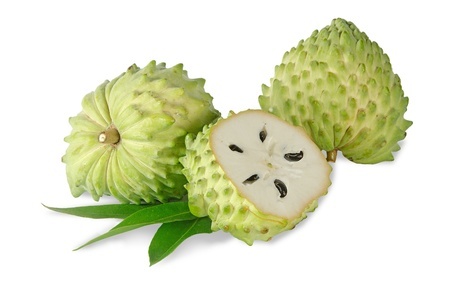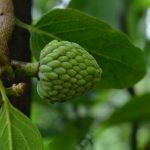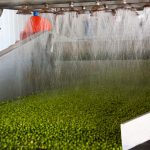
The Soursop fruit (Annona muricata L.) which is well known worldwide, is also known in South America as the Guanabana or specifically in Brazil as Graviola. It has a delicious white pulp, with tones of candy and smooth cream. It is commonplace in tropical markets, but rarely found fresh anywhere else. Inside its thin, leathery, green flesh is a large mass of creamy pulp, usually intermixed with 50-100 black seeds. It is native to the West Indies, but nowadays, the soursop has spread throughout the humid tropics and is widely grown commercially.
Cultivation
The fruit is borne on a small to medium sized tree growing up to 8m (25ft). It is hardy to 32°F. Soursop trees always require warmth and humidity, plenty of water, and are killed at temperatures below 32°F/0°C. The tree will not survive outside anywhere in the continental US except in Southern Florida, where it is grown commercially but only to a limited extent. In the tropics, soursops are grown from sea level to 1000m, particularly in humid regions where the tree grows particularly well. Soursop’s cannot tolerate standing water, and their roots are shallow, so it does not require a very deep soil base.
Propagation
Despite many named cultivars, soursops are commonly grown from seed. Trees can also be propagated by grafting and budding methods. Grafting of cherimoya and sugar apple trees and vice versa, onto soursop has thus far been unsuccessful. Soursop seeds can be stored for several months before planting. Germination of seeds usually takes three weeks, but under sub-optimal conditions can be delayed for up to 2-3 months. Seedlings of 6-9 month age are usually large enough to be set out in the field, or used as rootstocks for grafting.
Uses
The large, elongated, somewhat ovaloid fruit, can be up to 12″ long and 6″ wide and usually weighs several pounds. The fruit is covered in small knobby spines that easily break off when the fruit is ripe. The thin, inedible, leathery green skin cuts easily to yield the large mass of cream colored, fragrant, juicy, and somewhat fibrous, edible flesh. The least fibrous are the most popular. A typical soursop contains anywhere from 30-200 black-brown seeds, each about 1/2″ long and 1/4″ wide and enclosed in a separate “pocket” of flesh. There are known seedless varieties, but they are rare, and tend to have fibrous flesh.
Soursop’s make excellent ice creams, sherbets and beverages throughout much of Central and South America. Sweet varieties of the fruit can be eaten raw, and are often used for dessert. Nowadays, Soursop ice cream is marketed under its Spanish name “Guanabana” and is found in specialist supermarkets. Preserved soursop in syrup is also found in many ethnic markets. The canned pulp is pureed or blended for home use and produces an exceptional dessert, although fresh pulp is more desirable. Immature soursops are often cooked, and eaten as vegetables.
Nutrition
Soursops are high in vitamins B1, B2 and C. The leaves and roots of the tree have various attributed medicinal properties.
Possible Clinical Value In Fighting Cancer
Soursop contains acetogenins which are also found in avocado extracts. These are being investigated for their cancer inhibiting properties. Those found in soursop include annonacin, along with other compounds called quinolones, annopentocins and two unusual alkaloids, coreximine and reticuline.



In parts of Africa I read that the soursop seeds, leaves, roots and bark are used as a poison to kill off insects. Do you know if this makes this fruit unsafe to eat ?